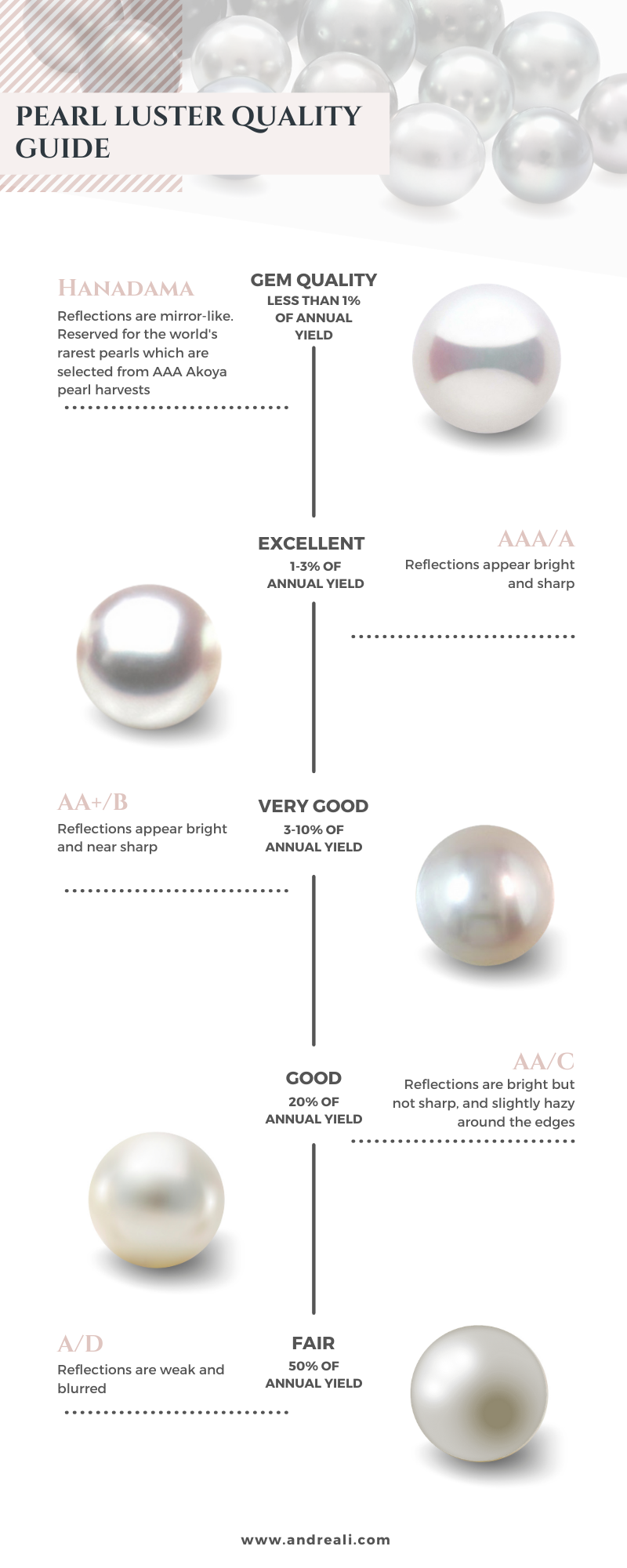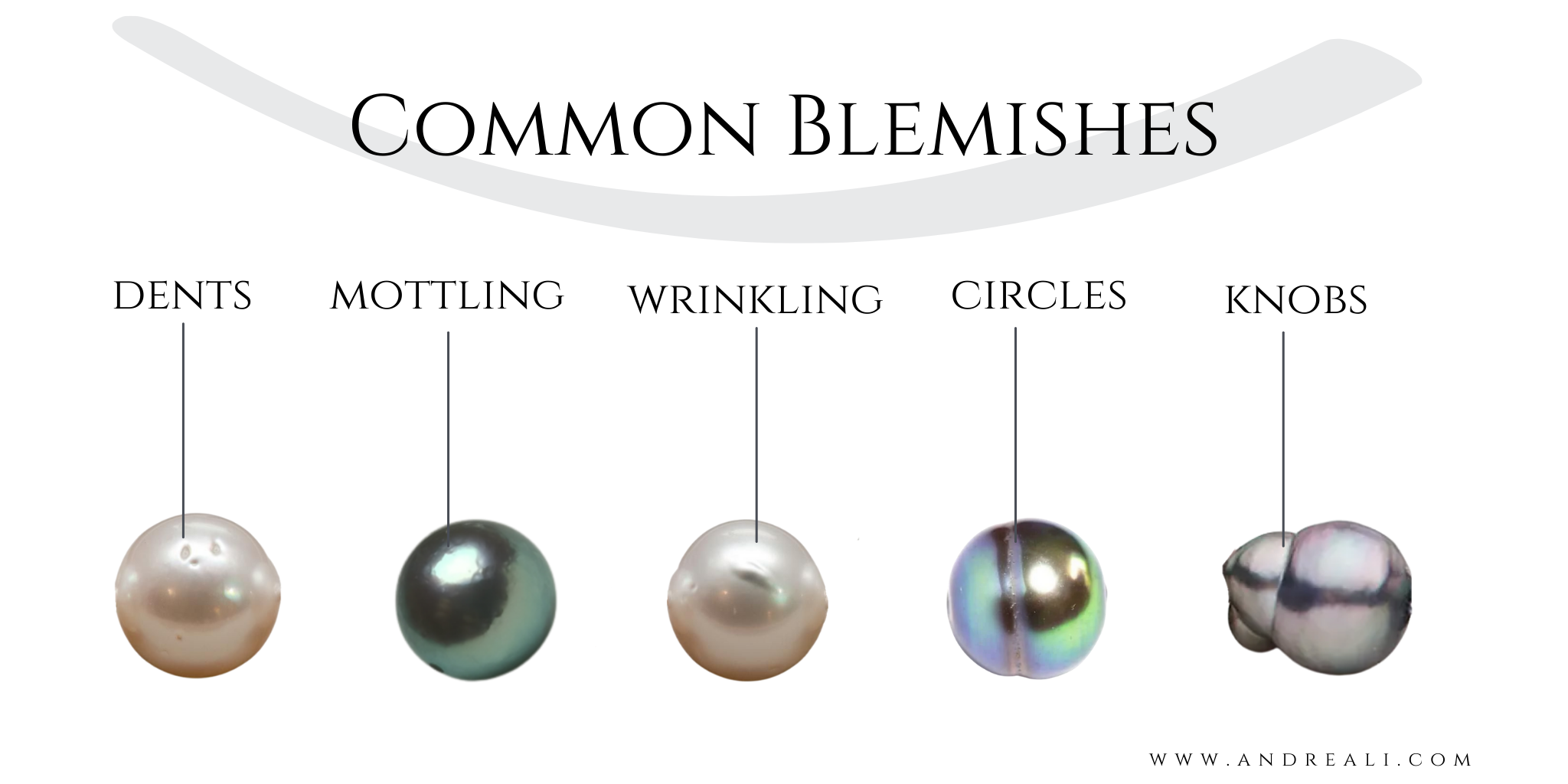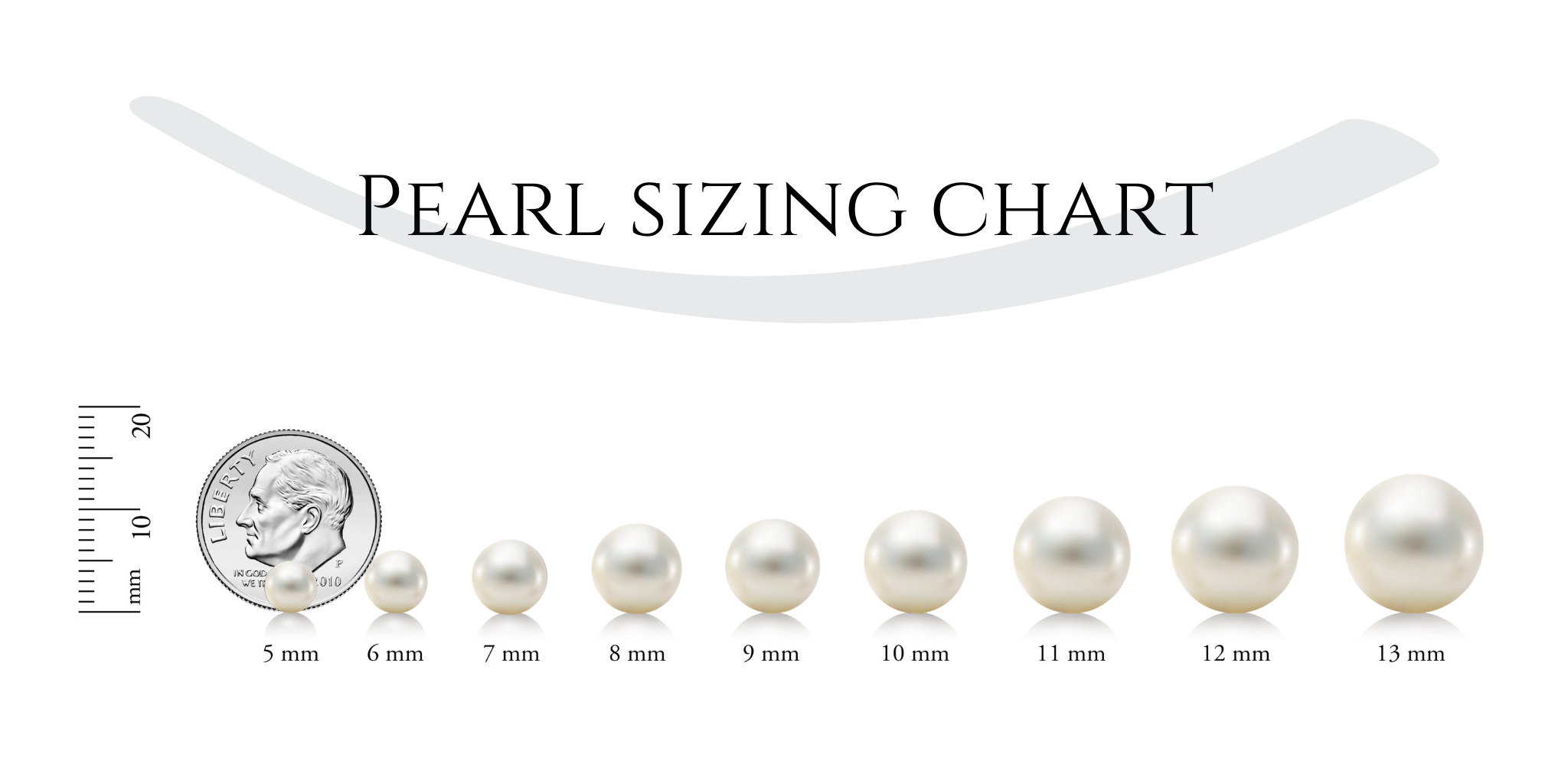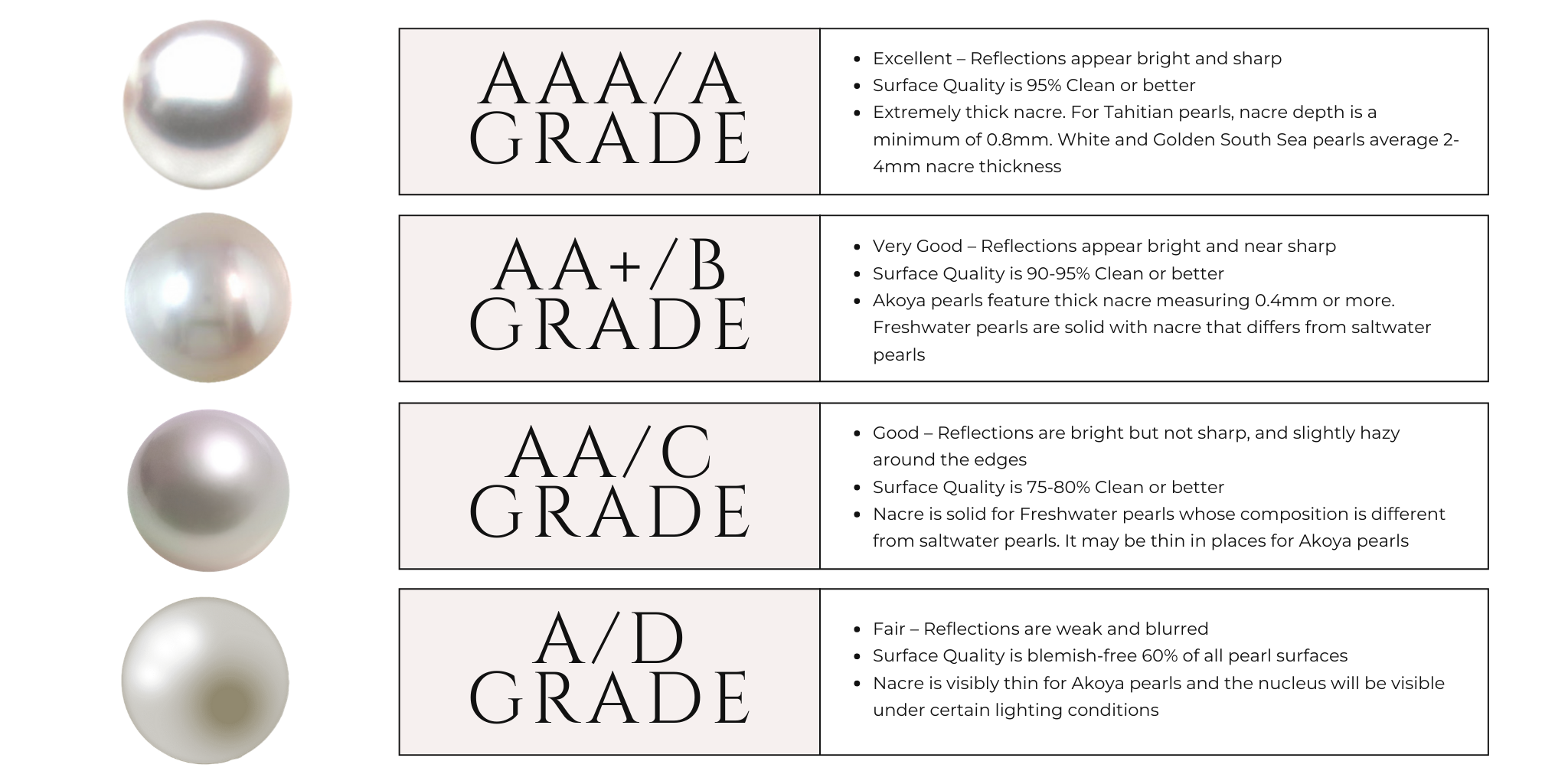Pearl Grading Basics
I came across a quote the other day that read, “To be worthy does not mean to be perfect.” This is just as true for anyone who is having an existential crisis as it is to pearls. (jewelers brain leap of logic, I know) No pearl is perfect; even the pearls considered the most valuable in the world are not.
So, what determines a pearl’s value if the gold standard of ‘flawless’ is impossible to achieve?
Pearls’ organic origins will always prevent its ability to produce a perfect version, but plenty of other visual and physical attributes can impact the cost. Get to know what these are, and you’ll be able to evaluate the value of a pearl with the keen eye of a trained professional.
In this post, you’ll get clarity on the seven factors that determine a pearls’ value -
Nacre Quality
Luster
Surface Quality
Size
Shape
Origin
Color
Before we get this pearl party started, it’s important to note here that references to pearls are for cultured pearls only. Natural pearls are far too rare for there to any viable market for them in modern times. All pearls farmed, processed, and sold today are entirely cultured.
Pearl Grading Guidelines
Navigating the waters of pearl grading can be tricky. The reason for this is a little surprising. Pearl grading is not standardized, which means that anyone in the supply chain from farmers, to sellers or auction houses, can all have different standards of grading the pearls’ quality - yikes!
The good news is that regardless of the grading system, the factors that determine a pearl’s quality are consistently the same. Knowing what these industry ‘standards’ are will help you smartly assess a piece of jewelry with pearls the next time you shop for one.
So, let’s dive in to get you some clarity on the seven factors used in pearl grading.
Nacre Quality
I list this factor first due to its overall impact on the remaining characteristics. The thickness of a pearls nacre layer significantly affects its beauty and wearability.
Nacre is the silky, crystalline coating of a pearl made of aragonite. These crystals refract light as it passes along the pearl’s surface, creating a shimmering iridescence—the more layers of nacre increase a pearls’ brilliance and durability.
Tahitian pearls have strict standards for measuring the quality of nacre for export. Pearls with little to no luster due to lack of nacre won’t make the cut. Instead, their nuclei are recycled. The pearls also need to meet the requirements of 0.8mm nacre depth (the average depth is 1.0mm) per side to qualify for export. This is measured at random by the Periculture Department of the Pearl Ministry for nacre thickness.
Luster
Luster refers to a pearls’ inner-glow produced by the light passing through the multiple layers of nacre. A pearl with well-layered nacre will appear bright and shiny. This can be visually measured by how sharp the reflections are along the pearl’s surface.
It’s important to note here that although pearl cultivation directly influences Mother Nature’s process, high-quality pearls are still rare. Only fifty percent of nucleated pearls survive to bear pearls. Out of that fifty percent, twenty percent produce pearls worthy of selling.
The pearls that make their way into fine jewelry collections make up 3% of annual yields. High jewelry collections include less than 1% of all pearls harvested.
The pearl luster quality chart goes further to illustrate just how special and occasional it is for an oyster to produce a gem-quality pearl.
In the rare instance that they do, the results are quite spectacular and valuable. The pearls that have what it takes to be gem-quality are selected from the world’s top-graded pearls.
These rarities contain qualities that are so exceptional that they are separated from the best AAA graded pearls and sent to the Pearl Science Laboratory in Tokyo. This organization is responsible for testing and assigning Hanadama certifications to pearls who qualify.
Surface Quality
I mentioned above about the impossible achievement of the perfect pearl. Anything with organic origins will inherently have imperfections. Even pearls with thick nacre can have surface characteristics such as wrinkles, tiny bubbles, spots, or other small blemishes.
Most of these do nothing more than affecting the cosmetic appearance to lower the grade of a pearl. However, some irregularities such as chips or gaps can significantly compromise a pearl’s durability causing it to peel or crack.
Blemishes or inclusions to look for -
Wrinkles - Some pearl varieties are nucleated without the intent for them to be round. These pearls’ odd shapes cause the nacre to form unevenly to become a typical, even desirable attribute. But for round pearls, surfaces that aren’t smooth will be graded lower.
Spots - These are slight color variations of the pearl.
Abrasions - These are scratches or scuffs that impact the luster of the pearl.
Dents/Divots - Indentations in nacre that vary in size.
Mottling/Bulleting - A light plating pattern that can form on the surface of the pearl while it’s created inside the oyster. This particular blemish is not considered an inclusion, but instead, it indicates a thick nacre layer and does not count towards a lower grade.
Kobs/Tips - These are growth characteristics and are also not necessarily counted as inclusions unless they are chipped, which can affect the durability of the pearl.
Circles - Circling is another growth characteristic that imparts a unique look and is not considered an inclusion.
Size
Leo Tolstoy, the author of War and Peace, wrote, “The two most powerful warriors are patience and time.” That’s just as true for a pearl’s ability to grow large with time being money - and is another contributing factor to a pearl’s value.
It takes at least a year and a half for an oyster to produce a pearl. If a pearl is allowed more time, it can produce an even larger pearl. The problem is that the unpredictable whims of Mother Nature make it difficult for an oyster to survive, let alone create a pearl in the minimum timeframe.
The difficulty of cultivating large pearls makes them rarer and more valuable. Prices can go up rapidly with each millimeter in size. The largest cultured pearl on record is a 29.65mm South Sea Baroque, roughly the size of a golf ball. Wow - I wonder what that fetched at Sotheby’s.
To get a little context of the different sizes, you can refer to the sizing chart below.
Shape
Most of the time, when you think of pearls, iconic images of Audrey Hepburn are conjured up in your mind. You wouldn’t be wrong; most people would think of a classic strand of pearls when it comes to pearl jewelry. That’s why round pearls are the gold standard in pearl grading.
Aside from perfectly round pearls, jewelers have many desirable shapes to include in their designs. These shapes tend to have more modern appeal due to their more unusual qualities. The most popular of these pearls is the baroque shape among consumers causing them to be in high demand.
Here are some of the more common shapes you may encounter in your pearl discovery journey.
Origin
If the apple doesn’t fall far from the tree, then the same could be said about the regions of the world where pearl cultivation reigns. Mikimoto, the son of a Japanese noodle maker, produced the first cultivated pearl in 1893. His discovery spurred an entire industry that still operates in the same or similar regions of the world today.
The different types of saltwater pearls are aptly named after the areas where they are farmed - making it easier for the rest of us who aren’t pearl experts, thank goodness. Meanwhile, all freshwater pearls come from China.
Below are maps of the world’s various regions where these tiny treasures are cultivated, sorted, processed, and exported. Once this happens, they will be making their way to jewelers across the world like me and eventually into your jewelry box.
Akoya
South Sea
Tahitian
Freshwater Pearls
Color
Classic pearl color is often thought of as white or cream, but the rich palettes in Mother Nature are far too whimsical to end there. Besides, if you haven’t noticed, she likes to show off her beauty in spectacular fashion. This is especially true for the gorgeous shades of many saltwater varieties and some freshwater as well.
Different regions which dictate the type of pearl are known for producing pearls of a particular color. Specific species of oysters used to cultivate in these areas are what influence a pearl’s color. More specifically, the color of the oyster’s lip, a portion of the outer shell, and the microscopic pigments in the protein layers of conchiolin.
For instance, the black-lipped oyster, the Pinctada Margaritifera lends its darker hues to the exotic greys of Tahitian pearls. Simultaneously, the presence of aragonite crystals in the pearls’ nacre creates iridescent overtones.
How color plays into pearl grading depends on two things -
Body Color - This should be even throughout and absent of discoloration or mottling
Overtones - These should be distinct, giving the pearl a glowing luminescence of pinks, greens, and silvers
Regional Colors for Pearls
Tahitian - These pearls are exotic, with dark colors, and known for their baroque shapes. Depending on their size and quality, a strand of Tahitian pearls can cost from $500 to more than $25,000.
South Sea - Pearls from this region are produced by the oyster Pinctada maxima and are known for their size and exceptional quality of golden-colored pearls. A strand of South Sea pearls can range from $1,000 to over $100,000.
Akoya - These pearls were the first ever to be cultivated and are smaller in size. They are more traditional in color, producing pearls that are classically round in white and metallic shades. A strand of Akoya pearls can cost from $300 to more than $10,000.
Freshwater - These pearls come in a vast range of shapes and sizes, and colors. Round freshwater pearls look almost identical to Akoya pearls but are less expensive, with a strand ranging from $50 to $2,000.
Become a Savvy Shopper
Below is a quick reference chart with the different levels of grading and attributes that help define them.
Conclusion
By now, you should have a pretty thorough understanding of all the elements that are involved in pearl grading. However, in most instances, from the casual consumer to a jewelry enthusiast, a visual inspection of pearls is all you need to evaluate the quality.
A pearls’ luster is immediately apparent simply by looking at it and is indicative of the other factors that determine its value. The surface of a pearl can tell an in-depth story of it, including how it was formed inside the oyster.
Use my quick reference chart above with the different levels of grading and attributes that help define them. You can also download my Ultimate Guide to Pearls as a handy resource and visual reference below.




















